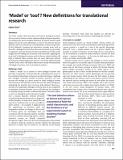| dc.contributor.author | Sive, Hazel | |
| dc.date.accessioned | 2012-11-15T17:36:21Z | |
| dc.date.available | 2012-11-15T17:36:21Z | |
| dc.date.issued | 2011-03 | |
| dc.identifier.issn | 1754-8403 | |
| dc.identifier.issn | 1754-8411 | |
| dc.identifier.uri | http://hdl.handle.net/1721.1/74648 | |
| dc.description.abstract | The term ‘model’ often describes non-human biological systems that are used to obtain a better understanding of human disorders. According to the most stringent definition, an animal ‘model’ would display exactly the same phenotype as seen in the relevant human disorder; however, this precise correspondence is often not present. In this Editorial, I propose the alternative, broader term ‘tool’ to describe a biological system that does not obviously (or precisely) recapitulate a human disorder, but that nonetheless provides useful insight into the etiology or treatment of that disorder. Applying the term ‘tool’ to biological systems used in disease-related studies will help to identify those systems that can most effectively address mechanisms underlying human disease. Conversely, differentiating ‘models’ from ‘tools’ will help to define more clearly the limitations of biological systems used in preclinical analyses. | en_US |
| dc.description.sponsorship | Simons Foundation. Autism Research Initiative | en_US |
| dc.description.sponsorship | Broad Institute of MIT and Harvard. Stanley Center for Psychiatric Research | en_US |
| dc.language.iso | en_US | |
| dc.publisher | Company of Biologists, The | en_US |
| dc.relation.isversionof | http://dx.doi.org/10.1242/dmm.007666 | en_US |
| dc.rights | Creative Commons Attribution-Noncommercial-Share Alike 3.0 | en_US |
| dc.rights.uri | http://creativecommons.org/licenses/by-nc-sa/3.0/ | en_US |
| dc.source | Company of Biologists | en_US |
| dc.title | ‘Model’ or ‘tool’? New definitions for translational research | en_US |
| dc.type | Article | en_US |
| dc.identifier.citation | Sive, H. “‘Model’ or ‘Tool’? New Definitions for Translational Research.” Disease Models & Mechanisms 4.2 (2011): 137–138. | en_US |
| dc.contributor.department | Massachusetts Institute of Technology. School of Science | en_US |
| dc.contributor.department | Whitehead Institute for Biomedical Research | en_US |
| dc.contributor.mitauthor | Sive, Hazel | |
| dc.relation.journal | Disease Models and Mechanisms | en_US |
| dc.eprint.version | Final published version | en_US |
| dc.type.uri | http://purl.org/eprint/type/JournalArticle | en_US |
| eprint.status | http://purl.org/eprint/status/PeerReviewed | en_US |
| dspace.orderedauthors | Sive, H. | en |
| dc.identifier.orcid | https://orcid.org/0000-0002-4890-424X | |
| mit.license | PUBLISHER_CC | en_US |
| mit.metadata.status | Complete | |
